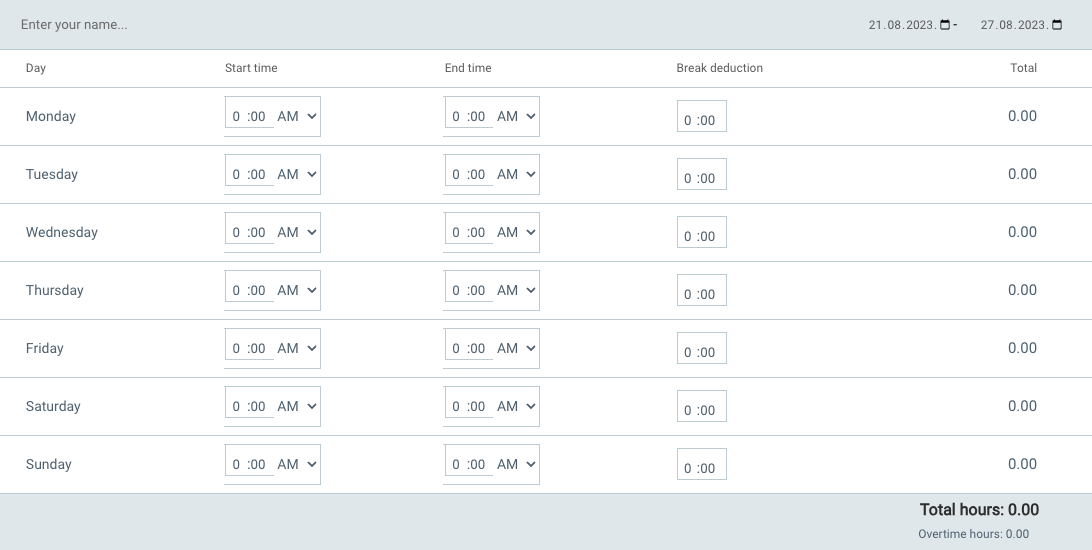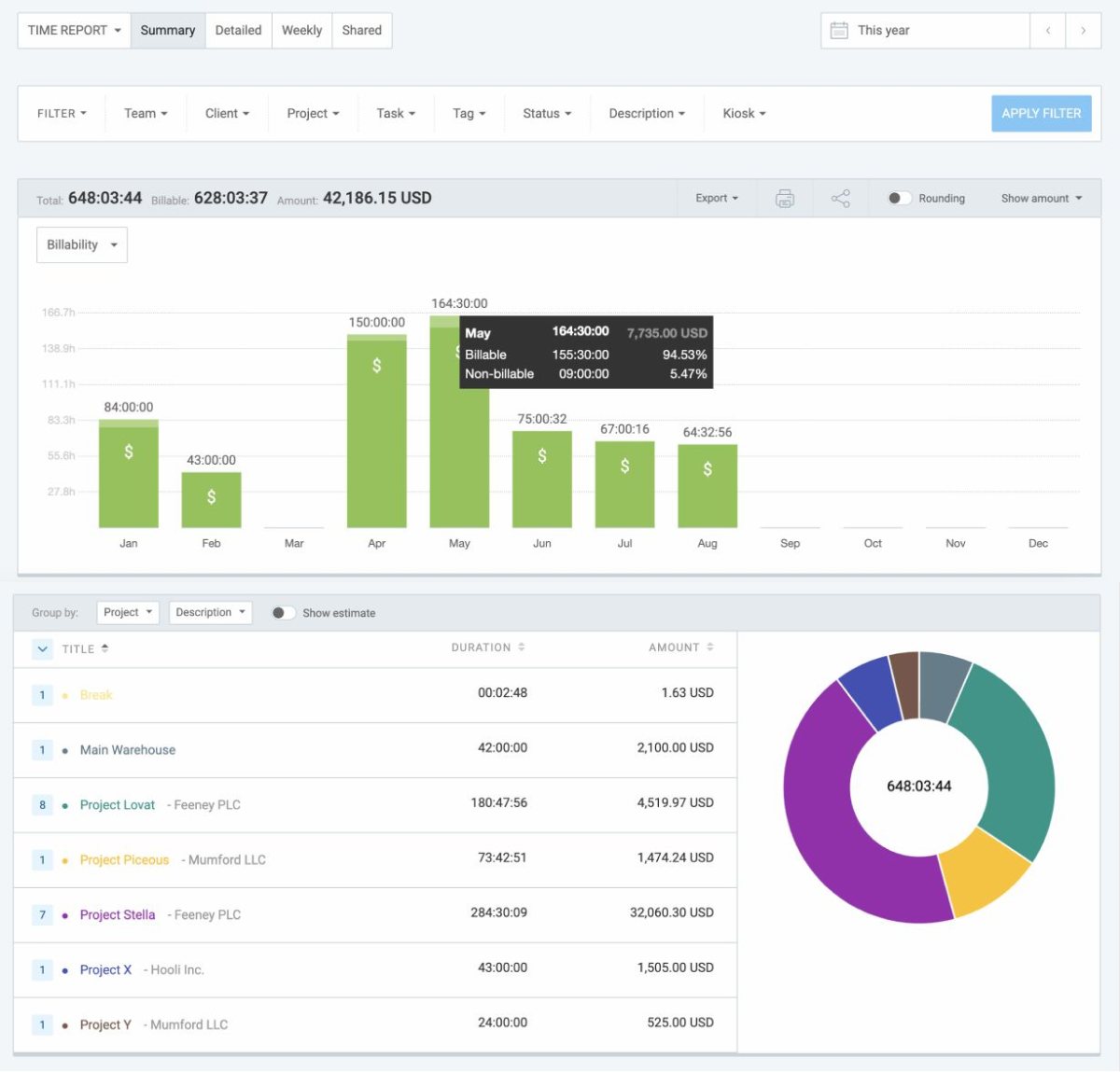How many work hours do you work in a year?
Last updated on: September 22, 2023
The answer to this question may sound simple at first — full-time workers work 2,080 hours per calendar year.
However, it’s a bit tricky to give a clear-cut answer in practice.
Another question may also pop into your head, such as why calculate yearly work hours. It’s something we’ll discuss later in this text, but let’s put it this way — knowing how many work hours per year we have will help you stay on top of your budget and plan your spendings (whether as an individual or a business owner), to name a few reasons.
Stay with us because in this blog post, we’ll help you:
- Calculate your total annual work hours,
- Calculate your total annual non-work hours, and
- Convince you to start tracking your work hours by giving you legitimate reasons to do so.
Let’s jump right into it!

Table of Contents
How many working hours are there in a year?
As mentioned, broadly speaking, there are 2,080 working hours per year — that’s 40 hours of work per week.
The calculation goes as follows: multiply 40 hours of work per week (which is a global norm) by 52 (number of weeks per calendar year), and you will get 2,080 hours a year.
The standard 2,080 work hours per year may fluctuate depending on whether it’s a leap year or not. In that case, there can be up to 2,096 working hours (260 to 262 working days within a year).
Still, a number of other factors may influence the calculation of your annual work hours, such as your work schedule, time off, holidays, overtime, to name a few. It’s quite unlikely that you would work throughout a calendar year without taking any time off, whether that’s vacation, sick or holiday leave.
Let’s walk you through the steps for calculating your total annual working time.
How many working hours in a year (based on your workweek)?
The Fair Labor Standards Act does not define the exact number of work hours a full-time or part-time employee must clock in, as it is solely established by the employer. Therefore, certain workers may work more or less than the standard 40-hour workweek and still be covered by the FLSA rules and regulations.
Now, if you don’t work a “traditional” 40-hour workweek (2,080 work hours/year), look at the following breakdown of different work schedules to find out their respective annual work hours:
- 20-hour workweek: 20 hours/week x 52 = 1,040 working hours/year
- 25-hour workweek: 25 hours/week x 52 = 1,300 working hours/year
- 30-hour workweek: 30 hours/week x 52 = 1,560 working hours/year
- 35-hour workweek: 35 hours/week x 52 = 1,820 working hours/year
- 37.5-hour workweek: 37.5 hours/week x 52 = 1,950 working hours/year
- 45-hour workweek: 45 hours/week x 52 = 2,340 working hours/year
- 50-hour workweek: 50 hours/week x 52 = 2,600 working hours/year
- 55-hour workweek: 55 hours/week x 52 = 2,860 working hours/year
- 60-hour workweek: 60 hours/week x 52 = 3,120 working hours/year
Remember that the said calculations refer to working hours on a yearly basis and do not include any time off or holiday. For the purpose of calculating your total hours in a work year, along with your time off and holidays, you will have to follow the formula we provided in the How do you calculate work hours per year (+ steps) section.
💡Clockify Pro Tip
If you would like to find out some interesting statistics about the average working hours throughout history or in countries around the world, read the following blog post:
How many non-working hours per year (based on your workweek)?
Now that you know your total annual work hours, based on your work schedule, let’s find out how many hours you don’t work in a year, referring to the same work schedule we mentioned earlier.
To find out how many non-working hours there are in a year, whether that’s a 40-hour workweek or other “non-traditional” work schedules, you’ll need to subtract total hours worked based on your working week from the total hours per year (there are in total 8,760 hours per calendar year):
- 20-hour workweek: 8,760 hours/year – 1,040 work hours/year = 7,720 non-working hours/year
- 25-hour workweek: 8,760 hours/year – 1,300 work hours/year = 7,460 non-working hours/year
- 30-hour workweek: 8,760 hours/year – 1,560 work hours/year = 7,200 non-working hours/year
- 35-hour workweek: 8,760 hours/year – 1,820 work hours/year = 6,940 non-working hours/year
- 37.5-hour workweek: 8,760 hours/year – 1,950 work hours/year = 6,810 non-working hours/year
- 40-hour workweek: 8,760 hours/year – 2,080 work hours/year = 6,680 non-working hours/year
- 45-hour workweek: 8,760 hours/year – 2,340 work hours/year = 6,420 non-working hours/year
- 50-hour workweek: 8,760 hours/year – 2,600 work hours/year = 6,160 non-working hours/year
- 55-hour workweek: 8,760 hours/year – 2,860 work hours/year = 5,900 non-working hours/year
- 60-hour workweek: 8,760 hours/year – 3,120 work hours/year = 5,640 non-working hours/year
Knowing the number of your non-working hours may aid you in planning free time, vacation, or just as a reference to make sure you maintain a good work-life balance.
How do you calculate work hours per year (+ steps)?
As said earlier, there are factors that you must take into account before you start calculating your annual working hours. Regardless of your work schedule (and certain other steps throughout the calculation), you will have to subtract any time off you took for the given year, including:
- Vacation days,
- Sick days, and
- Holidays.
Bear in mind that vacation days, sick days, and holidays are not fixed amounts, and they might depend on your company’s policies or even the state you live in.
Now, to calculate the total working hours per year, look at the equation below:
Total hours in a work year = (Number of working hours per week x 52) – [(PTO days + number of paid holidays) x number of working hours per day]
To make sure you get the most accurate calculation of your work hours per calendar year, we’ve broken down the equation into 4 in-depth steps for better understanding.
💡Clockify Pro Tip
Before you jump into calculating your annual work hours, stop for a moment to read about PTO, holiday, and other employee leave types in different states across the US here:
Step #1: Track your weekly work hours and multiply them by 52
This is the first step to calculating your yearly work hours. Once you know how many hours you work per week, it’s easy to calculate your yearly total.
To calculate your weekly work hours, multiply the hours worked per day by the number of working days for that given week. Or, even more simply, make use of an automatic time card calculator to streamline the process of calculating your weekly hours.

A time card calculator records the start and end times of your work day, calculates your overtime for each day, and lunch break periods (which are deducted from the work hours automatically), too.
Finally, you can download your time card for personal archive or print it out and show it to your employer. Or, such as in this case, you can calculate your weekly hours hassle-free for the purpose of obtaining the total hours in a work year.
Now that you have the number of hours worked per week, multiply it by 52 (number of weeks per calendar year).
Let’s say you’ve tracked 35 hours of weekly work (including overtime), and when you multiply it by 52, you get:
35 hours of work/week x 52 = 1,820 working hours/year
Of course, this is not the number of hours we are looking for since you will need to count in the time you took off, along with holidays, so let’s calculate those in the next section.
Step #2: Calculate PTO and holidays
The next step towards calculating your working hours per year is to consider how many hours you were absent from work (only paid time off counts). This includes vacation time, sick leave, and paid public holidays.
Don’t forget that, according to the US Department of Labor, no employer is liable for providing their employees with paid vacation leave including sick leave or holiday leave (basically for any time not worked). Also, the number of vacation days depends on the length of time spent with the employer. Namely, one-third of the private industry workers in 2021 received 10 to 14 days of paid vacation after the first year of employment, while 33% of private industry workers with 10 years of experience received between 15 to 19 days of paid vacation.
As for public holidays, the number of paid holidays you get also depends on your employer. However, the US recognizes 11 annual holidays:
- New Year’s Day (January 1),
- Birthday of Martin Luther King, Jr. (Third Monday in January),
- Washington’s Birthday (or Presidents Day; third Monday in February),
- Memorial Day (Last Monday in May),
- Juneteenth National Independence Day (June 19),
- Independence Day (July 4),
- Labor Day (First Monday in September),
- Columbus Day (Second Monday in October),
- Veterans Day (November 11),
- Thanksgiving Day (Fourth Thursday in November), and
- Christmas Day (December 25).
In addition, Inauguration Day (January 20) is also a public holiday, but it is held every four years and considered a paid holiday for federal employees living in the Washington, D.C. area only.
Now, to proceed with your annual work hours calculation, add up all the hours of paid time off you took, including holidays, and prepare for the next step in your calculation.
💡Clockify Pro Tip
Don’t forget to take time off! If you’re wondering how, head to the following link for more details:
Step #3: Multiply the number of total days you took off with the number of hours you work per day
If you, for instance, worked 8 hours a day (no overtime) and had 9 days of vacation that same year, you had a total of 72 hours of vacation time.
Say you also had 11 paid holidays in that certain year and, again, worked 8 hours a day — you had a total of 88 hours of holiday time.
The total number of hours you took off from work equals 160 hours a year (72 hours of vacation + 88 hours of holiday).
Step #4: Subtract total time off from annual work hours
Now that you have all the numbers you need, subtract the number of hours you didn’t work for that year (160) from the total number of hours worked (1,820), just like in the equation that follows:
1,820 – 160 = 1,660 total hours/work year
Finally, your total annual work hours equal 1,660.
Why is it important to calculate how many work hours there are in a year?
Being aware of how much time you spend at work comes with many benefits. As a matter of fact, you’ll have spent roughly a third of your life at work. Calculating the exact number of hours you spend working each year may create a work-life balance that will make you prosper on and off the clock (among other things).
Take a look at other benefits of calculating your total working hours per year in the section below.
Benefit #1: Knowing the number of your annual work hours helps you calculate your annual income
First and foremost, knowing how many hours you work in a calendar year will help you get a better insight into your earnings and keep tabs on how much money you spend. Hourly workers may greatly benefit from knowing how many work hours they clock in a year for the purpose of calculating their annual salary.
Whether you want to get valuable insight into your household income or make quality decisions for your business, calculating work hours is the path to successful financial planning.
💡Clockify Pro Tip
Make use of the following step-by-step guide to calculate your work hours and your payroll trouble-free:
Benefit #2: Calculating annual work hours helps with maintaining a quality work-life balance
According to the World Happiness Report from 2023, Finland, Denmark, and Iceland take up the first three positions on this flattering list. One of the main reasons for their happiness is that they boast quality work-life balance thanks to their envious employment policies such as short working hours, long vacations, and parental leaves, to name a few.
Compared to almost half of Americans who don’t use up their full paid time off, the Scandinavias can serve as a great example of the importance of having a balanced work-life balance. Being aware of how many work hours you clock in, stopping yourself from overworking, and using your PTO regularly can follow an optimal quality of life.
Bear in mind that working a traditional 40-hour workweek will equal a total of 2,080 work hours per year, which leaves enough time for you to live a balanced life. Anything more than that may require more effort and thorough planning in order to maintain a healthy work-life balance.
Start tracking your work hours as of today, and rest assured your well-being remains unhindered.
💡Clockify Pro Tip
Here’s something you might find interesting, if you’re looking to shorten your workweek:
Benefit #3: Determining work hours helps with calculating your hourly rate
If you are paid a fixed salary rather than by the hour, you may want to know how much money you earn per hour. You can easily determine your hourly rate by dividing your annual income by the number of hours worked per year.
So, for instance, if you’ve calculated that you worked 2,080 hours in a previous year, and your annual salary for that year was $45,000:
$45,000 / 2,080 = $21,6 per hour
Being mindful of their annual work hours, salaried employees may determine their hourly wage more easily.
💡Clockify Pro Tip
Which one is better for you, salary or hourly employment? If you still can’t decide, maybe this blog post will help you figure out:
Benefit #4: Calculating yearly hours helps employers abide by labor regulations
As an employer, it’s crucial to understand your legal responsibilities towards your employees. Making sure you keep an accurate track of your employees’ work hours per year will help you do the following:
- Compensate your employees appropriately (whether that’s regular or overtime hours, bonuses or commissions),
- Give promised benefits (PTO, retirement plan, etc.),
- Determine labor costs,
- Differ between part-time and full-time employees, and
- Provide employees with a harmonious life.
By keeping a thorough record of your employee’s annual work hours, you avoid making wage and hour violations that result in punitive measures.
Benefit #5: Exact calculations make a great ally to the HR department
It’s old news that the HR sector deeply relies on the calculation of working hours for multiple reasons: determining wages/salaries, accounting for time off, differentiating between full time and part time workers, amongst others.
To get the most accurate calculations, HR managers can breathe a sigh of relief while using reliable time tracking software as their main tool for recording employee work hours.

Recorded work hours later help HR specialists automate payroll, invoice clients, create PTO policies, manage employee scheduling, and much more.
With Clockify, you just need to select the time range (Clockify gives you 2 options to choose from: ‘This year’ or ‘Last year’), and you can run detailed reports of employee work hours grouped according to projects. Furthermore, the tool automatically calculates pay (or cost) based on employee hourly rates.
So, yes, annual work hours play a huge role in HR operations, too.
Calculating work hours in a year: The bottom line
As you can see, there’s more to the story of calculating annual work hours than you might think. Since work hours greatly depend on the employee’s work schedule, there is no straightforward answer to the question How many work hours are there in a year.
Sure, if you work a traditional 40-hour work schedule, your annual work hours come down to 2,080. But you would still need to account for time off and holidays to be able to get the right number.
One way or another, we did our best to provide you with a detailed guide on determining your work hours alone. Also, we laid out notable benefits of calculating your annual work hours to stay on top of your work hours (for whatever reason).
Whether you are an employee or run a business, time tracking is an important part of both your work-life balance and overall success.
✉️ Do you calculate your annual work hours? What’s the most efficient way to do it? Let us know at blogfeedback@clockify.me, and we might include your thoughts in this one or one of our future articles. Also, if you liked this blog post, share it with someone you think could benefit from it.





